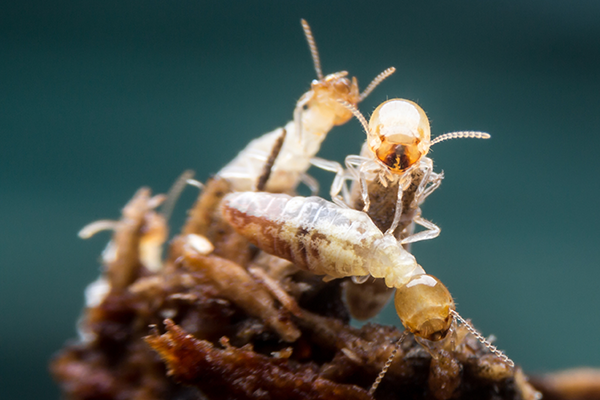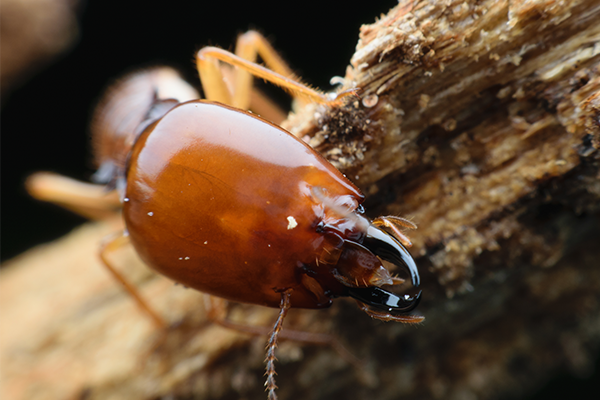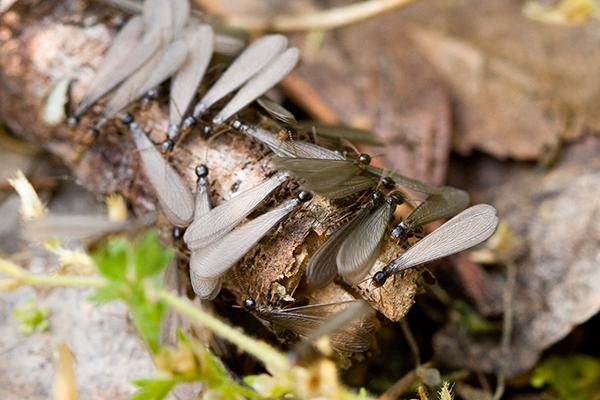What do termites look like?
Eastern subterranean termites live and nest together underground in large social colonies. Termites divide themselves into different castes, each caste having its own specific job to complete. Termite colonies consist of workers, soldiers, and reproductive members. What the termite looks like will depend on what caste that they are part of.

Workers
Workers comprise most of the termite colony. Workers spend their lives under the ground in the nest or inside the wooden structures they gather food from. Worker termites have a soft creamy white body, are wingless, blind, and relatively small.

Soldiers
The soldiers have a similar appearance to the workers but are larger and have an elongated yellow head, large, strong jaws, and short legs. The soldiers use their strong mandibles to defend the colony against their enemies.

Reproductive Members
The reproductive members of the colony are the largest (in size) members of the colony. They have wings that are twice as long as their body and are dark-brown to black. Reproductive members of a termite colony emerge (swarm) from a mature termite colony to find a mate and start a new colony.
Are termites dangerous?
The good news about termites is that they are not a dangerous species of insect for people to be around. They are not known to spread any diseases or bacteria, nor do they bite or sting. In fact, except for termite swarmers (reproductive members), it is very rare for people to ever even come into direct contact with termites.
What kind of damage do termites cause?
The bad news when it comes to termites is that that they are very destructive to property. Termites feed on the cellular material found in wood, and unfortunately, most homes and buildings have some wood inside them.
When termites find their way into a home, they are initially attracted to moisture-damaged wood and will cause damage to floors, ceilings, and walls. Once established, they will move on to feeding on and damaging sound wood, including items such as cabinets and wooden furniture.
What are the signs of a termite infestation?
Termites are often referred to as “silent invaders” because of their ability to enter into and live virtually undetected by property owners. It typically isn’t until the damages they have caused are finally noticed that the termite infestation is discovered. Termites can work undetected for weeks, months, or in some cases even years. Signs of a termite infestation include:
-
Finding wood in or around your home that is splintered, weathered, or has small holes on its surface.
-
Flooring that “feels” spongy when you walk across it.
-
Walls will sound hollow when you tap on them.
-
Doors and windows that appear warped and are no longer opening or closing correctly.
-
Finding mud tubes running along the ground toward your home, running up your home’s foundation, or running along your home’s basement walls. Termites travel to and from their nest in these mud tubes to limit exposure to outside elements and predators.
-
Observing a termite swarm. During the spring season, winged termites will fly from a mature colony to mate, creating a termite “swarm” in the process.
What is a termite swarm?
A termite swarm occurs when a termite colony has reached its occupancy limit, and it is time to expand and create new colonies and nesting areas. A termite swarm typically occurs in the spring season, in the morning, after a rainstorm when the temperature and humidity are just right. A large group of winged termites will emerge from the colony; they are poor flyers and easy prey, so large numbers are key to the success of new colonies. Soon after emerging from the colony, the swarmers will discard their wings, find a mate, and find the perfect spot to create a new underground nest.
What's the difference between winged ants and termite swarmers?
Winged ants and termite swarmers look very similar, but if you look closely, you can see some fairly obvious differences between the two. Despite their differences, they have in common that if you see either on or in your home, seek professional help immediately.
-
Termites have straight antennae while the carpenter ant’s antennae are bent.
-
Carpenter ants have a pinched waist, while the termite’s waist is straight.
-
Carpenter ants and termites both have two pairs of wings-front wings and back wings. The termite’s front and rear wings are the same lengths, while the carpenter ant’s back wings are much shorter than their front wings.
-
Termite wings are twice as long as their body.
What should I do if I see a termite swarm?
If termites live behind your home’s walls and it becomes time for the reproductive to swarm, worker termites will create small exit holes in places like door or window frames, baseboards, or walls to allow the swarmers to exit. Swarmers typically move toward windows, doors, or any other light sources that they can find. With an indoor swarm, homeowners generally notice small piles of dead termites or their wings, under or around window sills, doorways, or light fixtures.
Suppose you witness a termite swarm outside, either on your property or very close to it. In that case, it usually means that a termite colony is located close by but not necessarily inside of your home. Witnessing an outdoor termite swarm gives you the chance to be proactive and stop the termites before they have the chance to find their way inside of your home to feed on its structural wood.
In any case, whether you are witnessing a termite swarm in your home, on your property, or a neighbor’s property, it should trigger you to contact the professionals at All Pest Control & Solutions. And have them perform a thorough termite inspection of your property and home.
How do I get rid of termites?
If you see signs of termites or their damages, contact All Pest Control & Solutions as quickly as possible. We will dispatch a wood-destroying insect inspector to your property to carefully inspect for existing termite activity, signs of termites, and termite damage.
If termites are found, our inspector will develop a customized treatment plan. Know that our termite treatments come with a one or five-year termite warranty for added peace of mind. To learn more about our termite inspections, treatments, and warrantees, give All Pest Control & Solutions a call today.
Does All Pest Control have any termite prevention tips?
Termites are moisture-seeking pests; therefore, the best way to prevent these destructive pests from becoming destructive inside of your Virginia property is to reduce moisture levels found both in and around your home. Reducing moisture levels can be accomplished through the following tips:
-
Install and use de-humidifiers, air-conditioners, and ventilated fans inside of your home.
-
Make sure that gutters are working to direct water away from the exterior of your home. Make sure that they always remain unclogged to help prevent water from overflowing and seeping into your home’s walls.
-
Fix any leaky pipes, fixtures, and faucets found inside and outside of your home.
-
Remove or replace wood in or on your home damaged by water.
-
Limit soil to wood contact around foundations and wooden structures (decks, playsets, sheds) on your property.
Additional Termite Articles
Why Termite Damage in Virginia Homes Can’t Go Untreated
Residential Services

Home Pest Control
Convenient for your schedule & effective against pests, our Home Protection plans protect your home and family!
Learn More >

Bed Bug Control
Innovative bed bug treatments designed to quickly, effectively and discreetly solve homeowners' bed bug problems.
Learn More >

Termite Control
All Pest's effective termite control treatments prevent wood-destroying termites from causing damage to your home.
Learn More >

Rodent Control
Get rid of rats and mice in your home with a comprehensive rodent control solution from All Pest.
Learn More >

Moisture Control
Using moisture control can help you avoid potential issues in your home, such as mold, wood rot, and termites.
Learn More >

Mosquito Control
Rid your property of those irritating, biting mosquitoes with All Pest's seasonal mosquito control.
Learn More >

Real Estate Inspections
All Pest Control's technicians are certified to identify and report signs conducive to wood-destroying insects.
Learn More >


